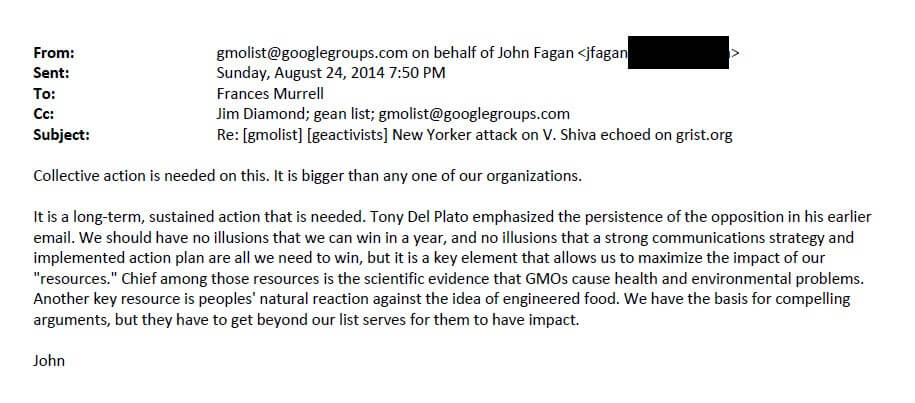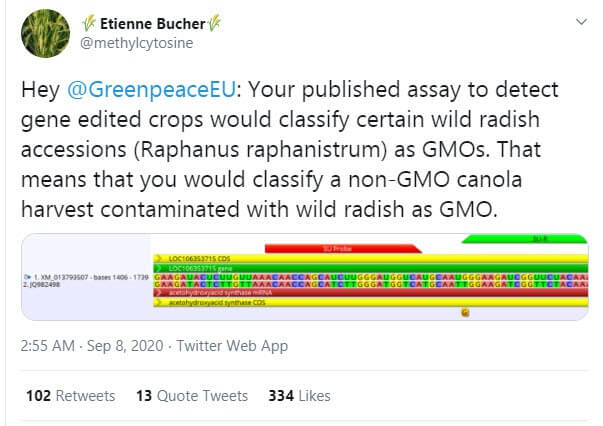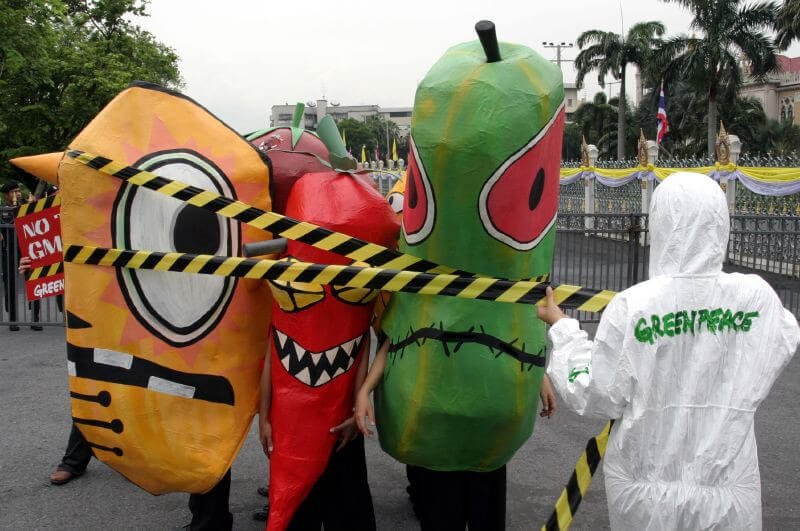In August, John Fagan, organic food champion, biologist and “Raja of World Peace” in the Maharishi organization, led a Greenpeace-funded study claiming that gene-edited crops developed with new breeding techniques (NBTs) like CRISPR can be “detected.”

This may seem unimpressive to most people, but the result is a big deal to anti-GMO activists like Fagan. Gene-edited crops may be essentially identical to conventionally bred plants; the only difference is that gene editing dramatically speeds up the breeding process, saving time, money and getting enhanced seeds into farmers’ fields much more quickly than was previously possible—all without inserting “foreign” DNA into the crop’s genome. This is the primary distinction between gene editing and transgenesis (GMO in the vernacular).
These facts aside, European law treats gene-edited and GMO crops the same. Commercial cultivation of both is effectively banned in the EU (farmers have access to only one transgenic corn variety), though political pressure is building to reform Europe’s strict regulations. Anti-biotech groups have been on a campaign to block these reforms since July 2018, just after the European Court of Justice first ruled on crop gene editing. Fagan’s paper was the latest contribution to this effort. If gene-edited and conventional crops can be distinguished, the argument goes, then the former should be regulated as GMOs.
But there’s a problem—a big one in fact: Fagan’s study actually demonstrated that it’s not possible to detect most gene-edited plants, therefore destroying the EU’s justification for regulating them as GMOs. It’s the perfect example of what we fondly call an “own goal.” And it illustrates how anti-science groups flog disinformation with the help of gullible journalists who stenograph their questionable claims for wide distribution.
Given the onslaught of disinformation we face in a post-COVID world, Fagan’s paper offers us the perfect opportunity to review the activist playbook and immunize ourselves against bad science and its harmful consequences.
Where we start: a slick campaign that needs a peg
As gene editing becomes an increasingly effective tool for improving agricultural production and reducing its environmental impacts, many countries (the US, Canada, Brazil, Argentina among dozens more) have split from the European Union (EU) on NBTs, exempting them from the expensive and exhausting regulations that govern GMO crops.
This is not only scientifically sound, it’s pragmatic. There is no way to detect gene edits in most cases. These changes look just like natural mutations found in wild plants, or the genetic changes induced by old-fashioned and EU-approved practices like bathing seeds in mutagens or irradiating them, or changes that occur in plants produced via tissue culture. The tests at our disposal cannot—I repeat, cannot—distinguish mutations caused by any of these techniques.
This creates a problem for Food Purity Rajas and other opponents of biotechnology. If these gene-edited crops gain public acceptance and don’t count as “GMO,” the organic industry will be at a competitive disadvantage. How could they justify a premium price for Non-GMO Project-certified corn flakes in those circumstances? Naturally, they have to challenge the efficacy and safety of gene editing to prevent such an outcome. Fear is their go-to currency in this effort, as John Fagan explained almost six years ago in a mailing list for anti-GMO campaigners, run by Claire Robinson of the activist website GM Watch. It’s part of a long-term plan to make people fear all engineered food.

Fagan recently gave credit for America’s rejection of GMOs to transcendental meditation (TM), which caused “a sharp increase in coherence in U.S. collective consciousness, when a large permanent group of TM practitioners was assembled in Iowa, USA.” I haven’t seen the evidence for that, though I’d be happy to take a look at the research if anyone can locate it. What is more likely, and supported by data, is that a long-term misinformation campaign made up of bad science and shock marketing scared parents everywhere into buying organic fruit snacks to avoid scary GMOs.
Down to the last detail, this tried and true activism strategy was deployed to influence the current discourse around gene editing. Besides his enthusiasm for TM, John Fagan also has training in molecular biology and operates a non-profit lab with the necessary testing capacity (incidentally, he also started a company that certifies products for the Non-GMO Project). Greenpeace, meanwhile, has an effective, stunt-based PR machine that can churn out multimedia presentations and widely read press releases, which sympathetic NGOs can dutifully amplify. But things didn’t turn out as intended this time.

It’s impossible to know which came first: the idea for a campaign to attack gene-edited crops, which needed supporting science, or a “study” in need of the PR muscle Greenpeace could leverage. Someday an intrepid investigative journalist might be able to work this out. But in any case, the outcome on September 7, 2020 was the release of a paper in the peer-reviewed journal “Foods,” which claimed to reveal a test that could uniquely and specifically detect the first commercial gene-edited crop, a variety of herbicide-resistant canola developed by the seed company Cibus. With a press release, media blitz, and slickly produced website, Greenpeace and other funders launched the #NowhereToHide campaign to promote Fagan’s paper and encourage EU regulators to treat this herbicide-tolerant canola as a GMO.
Similar to the guy who claimed he invented email, Fagan’s team implied they developed a new test to identify this crop. That’s not the case; the qPCR (polymerase chain reaction) method used in the study is well established for canola. Fagan’s novelty claim is therefore quite erroneous, as one scientist noted on Twitter. Nobody disputes that you can find point mutations, changes to a single DNA base pair, with qPCR. The key is that it’s impossible to determine if a variation is naturally occurring or purposefully induced. Many experts have pointed this out in response to the paper. The test would likewise detect herbicide-resistant plants that have been known to scientists and regulators since in 2002, from wild populations with that same mutation. Etienne Bucher, a plant geneticist based in Switzerland, tried to help Greenpeace grasp this:

But here’s the kicker: this canola is not gene edited. It is a somaclonal mutation that was found in the screenings for an herbicide-tolerant variety, one of those changes that occurs in tissue culture. So what Fagan’s team has, in fact, definitively proved: they cannot detect edited canola this way. Additionally, it appears this rapeseed could be classified as non-GMO in Europe, since it was developed with one of the “grandfathered” techniques not subject to the onerous EU GMO approval process.
Own. Goal. Reminds me of the time anti-vaxxers commissioned research that confirmed vaccines do not cause autism.
Let the goal-post moving commence!
After the scientific community made quick work of Fagan’s study, Greenpeace and activists like Claire Robinson at GMWatch began furiously backpedaling. Maharishi TM trainer and geneticist Michael Antoniou told the anti-GMO website that “the method they have developed reliably detects a single DNA base unit change, regardless of how it came about.” But he went on to assert that EU regulators should still rely on this test to detect the canola variety. This makes absolutely no sense, as the German Central Committee for Biosafety experts observed [automated Google translation]:
The publication by Chhalliyil et al does not add any new knowledge to the current state of science and technology. Rather, it proves that it is not possible to distinguish genome-edited plants from plants with spontaneously occurring mutations. Without prior knowledge of the manufacturing process [my emphasis], no statement can be made as to whether or not it is a GMO within the meaning of the ECJ [European Court of Justice] ruling.
GM Watch agreed, though it fell back on a legal argument to excuse the study’s weakness:
What the test cannot do is detect the technique by which a mutation was brought about – but under EU law it doesn’t need to. The way that the law deals with proof of origin for all GMOs – products of gene editing included – is to require the developer to declare that their product is a GMO and provide a test method and reference material.
In other words, if Cibus tells regulators its canola is gene edited, then regulators can determine if the canola is gene edited.
Organic GMO crops?
The media blitz around Fagan’s study was designed to promote organic food, but ironically enough, all this talk about identifying the source of mutations dredged up a potentially serious problem for the organic industry. In 2014, the USDA’s National Organic Standards Board investigated what kinds of genetic modifications led to many of the key organic crops, only to realize how difficult it would be to classify breeding and laboratory mutations:
Exploring this issue has brought to the attention of the subcommittee that engineered genetic manipulation of plant breeding materials has already occurred in many of the crop varieties that are currently being used in organic farming. A partial list:
- Disease resistant tomatoes (embryo rescue to introduce resistance genes)
- wheat and barley (double haploid technology using wheat and corn crosses along with embryo rescue and colchicine gene doubling)
- hybrid corn parent lines (double haploid to get homozygosity in 1 generation)
- Seedless tangerines and mandarins (mutations through irradiation)
- Brassica hybrids (cell fusion from radish traits)
Many of these techniques that were used in initial crosses that have now passed down through many generations may not be traceable any longer
The board realized that many of the crops in organic production right now were the result of laboratory processes (genetic engineering, one could say) that are undetectable with molecular testing. Why is this significant? Well, a cynical scientist could use Fagan’s test to “detect” mutations in organic tangerines just as well as Cibus’ canola, demonstrating the inanity of labeling the tangerine “non-GMO” and the canola genetically engineered.
Real consequences
Bungled though it was, this “parallel science” PR stunt helpfully illustrated how disinformation can sow confusion and lead to nonsensical policy. For example, Greenpeace celebrated when an Austrian health minister declared that Fagan’s test should be used to enforce the EU’s GMO rules. Well-known anti-crop biotech German politicians also eagerly embraced the results of the study. If people with so much influence over food safety rules in their countries can be fooled, you can see why junk science poses the risk it does.

Still, Greenpeace clearly lost this round. The activist-media juggernaut went down in flames before it could do too much damage—and GM Watch spent most of September explaining away Fagan’s study in the face of intense expert scrutiny. Expect the anti-science crusaders to fall back on these same tactics in the future, because it’s all they know how to do. But look forward to the fact that there are now scientists, battle hardened by years in the social media trenches, ready to blow air horns the next time an NGO launches a scheme like this.
Mary Mangan holds a PhD in cell, molecular, and developmental biology from the University of Rochester. She co-founded OpenHelix, a company that provides awareness and training on open source genomics software tools. Follow her on Twitter @mem_somerville































